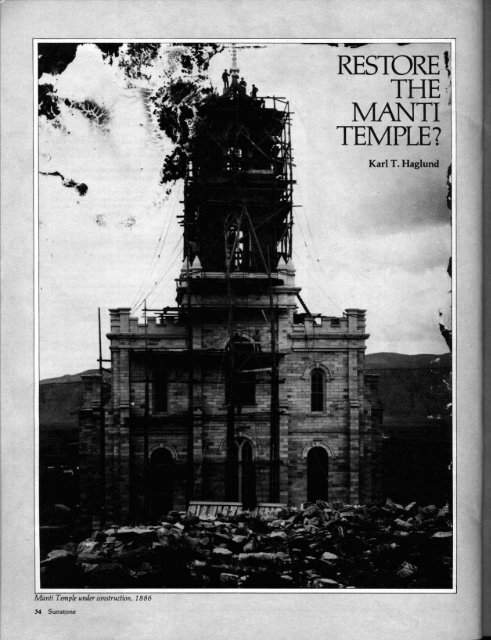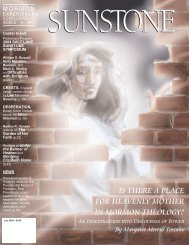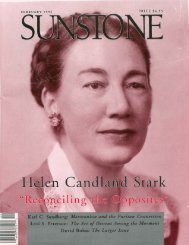Manti Temple under construction, 1886 - Sunstone Magazine
Manti Temple under construction, 1886 - Sunstone Magazine
Manti Temple under construction, 1886 - Sunstone Magazine
You also want an ePaper? Increase the reach of your titles
YUMPU automatically turns print PDFs into web optimized ePapers that Google loves.
I<br />
<strong>Manti</strong> <strong>Temple</strong> <strong>under</strong> <strong>construction</strong>, <strong>1886</strong><br />
34 <strong>Sunstone</strong>
w<br />
hen<br />
the First Presidency of the church announced<br />
in 1975 that the Bountiful Tabernacle<br />
would be preserved, they said:<br />
We feel. . .that because of its deep attachment to our<br />
sacred pioneer heritage, the Bountiful Tabernacle is the<br />
legacy and responsibility also of others beyond the<br />
Bountiful Utah Stake. It is a cherished treasure of the<br />
entire church.<br />
We express both gratitude and commendation to many,<br />
many people both within and without the church who<br />
have volunteered tocontribute time, fundsand energy in<br />
an effort to preserve this edifice.1<br />
The Bountiful Tabernacle was one of several restoration<br />
projects <strong>under</strong>taken by the Church during the last twenty<br />
years. Others included the Beehiveand Lion Housesand the<br />
old Council Hall in Salt Lake City, the Provo Tabernacle,<br />
and a number of historic building restorations and recreations<br />
in Nauvoo.<br />
Attitudes toward old Church buildings, though, are not<br />
simple. During those same years, the Ogden and Coalville<br />
Tabernacles were demolished, and numerous ward buildinas<br />
throughout Utah and Idaho came down. The St.<br />
~eor~e, ~isa, Hawaii, and Logan temples were substantially<br />
altered and remodeled.<br />
1n an unpublished paper presented at theBrighamYoung<br />
University Law School in 1976, Craig Call concluded that<br />
"the frustration of many concerned with preservation<br />
comes with the uncertainty prompted by the seeming<br />
contradictions between varying church actions. A general<br />
policy. ..covering a specified group of buildings determined<br />
by consultation with historical groups, would eliminate<br />
much of the mis<strong>under</strong>standing and apprehension."z<br />
Although such a policy has not been announced, the<br />
proposed remodeling of the <strong>Manti</strong> <strong>Temple</strong> represents a unique<br />
opportunity for the Church to restore one of its most significant<br />
landmarks. For a relatively modest expenditure, the few<br />
required changes could be made and the temple could be<br />
restored, rather than drastically remodeled, as a reaffirmatioh<br />
of the faith of its builders.<br />
During the last four years, the Church has <strong>under</strong>taken<br />
major repairs or remodeling of the St. George, Mesa,<br />
~awaii, and Logan temples. The most recent project was<br />
the <strong>construction</strong> of "a new building inside the old one-3 at<br />
the Logan <strong>Temple</strong>, at a cost of about eight million dollars.<br />
(For comparison, the Provo and Ogden temples, built in<br />
1972, cost $4,000,000 each; the new Jordan River <strong>Temple</strong>,<br />
three years of inflation after the Logan remodeling, is<br />
estimated to cost about fourteen million.) Each of the<br />
remodeled temples has been adapted for the use of the<br />
filmed presentation of the endowment ceremony.<br />
Original plans indicated that the <strong>Manti</strong> <strong>Temple</strong> would<br />
also<br />
~ - be .- renovated to accommodate the filmed endowment<br />
ceremony. It was recently announced that the live endowment<br />
presentation would be retained and that the original<br />
-<br />
endowment and sealing rooms would not be altered. Some<br />
unspecified functional changes, including an elevator and<br />
new sealing rooms, may be made.<br />
The <strong>Manti</strong> <strong>Temple</strong> is a unique opportunity for the<br />
following reasons. First, the restoration of the <strong>Manti</strong><br />
KARL T. HAGLUND is architectural historian for the Utah State<br />
Historical Society and is working on a dissertation on the architecture<br />
and landscape of the Sanpete Valley.<br />
<strong>Temple</strong> would be relatively inexpensive-much lesscostly,<br />
for example, than the re<strong>construction</strong> of the Logan<strong>Temple</strong>.<br />
The changes made to the <strong>Manti</strong><strong>Temple</strong> havebeen few, and<br />
there are a number of areas in the building which are now<br />
<strong>under</strong>-utilized. Even the annex to the temple, although<br />
added to sometime after the turn of the century, retains<br />
much of the original structure. The famous spiral staircase,<br />
now blocked off by the arrangement of the first floor, could<br />
be made functional again by a relatively simple change in<br />
the floor plan.<br />
Second, because of the very slow population growth in<br />
central Utah, there is not the need for greatly expanded<br />
facilities in <strong>Manti</strong> that there was with othertemples. (It has<br />
been suggested that new sealing rooms be built in an<br />
exterior addition to <strong>Manti</strong>. The reason the old sealing<br />
rooms are often busy in <strong>Manti</strong>, though, is because they are<br />
so exquisitely crafted-many members who normally go<br />
to Provo for their regular temple work choose to drive the<br />
extra distance to <strong>Manti</strong> for marriages and other special<br />
sealing sessions. Building new sealing rooms would not<br />
reduce the number of people who want to be married in the<br />
old sealing rooms.) Most of thegrowthof thechurchin the<br />
<strong>Manti</strong> <strong>Temple</strong> district is in Denver, which suggests that<br />
money which might earlier have been assigned for remodeling<br />
<strong>Manti</strong> could go instead for a temple in Denver or<br />
another, more central location.<br />
Manfi <strong>Temple</strong> Today<br />
Finally, the <strong>Manti</strong> <strong>Temple</strong> is perhaps second only to the<br />
Salt Lake <strong>Temple</strong> in historic and architectural significance.4<br />
While several of the other temples have been<br />
altered at various times, the <strong>Manti</strong> <strong>Temple</strong> is virtually<br />
unchanged since its dedication.<br />
What would be involved in a temple restoration? The<br />
crucial decision is determining the architectural attitude<br />
toward the building. Restoring a building should mean that<br />
the contemporary design methods and tastes are set aside,<br />
so that the philosophy and style of the original builders can<br />
be followed. It seems clear that the builders of the early<br />
March-April I979 35
<strong>Manti</strong> <strong>Temple</strong>, 1888<br />
Utah temples intended that the temple grounds, as well as<br />
the building itself, be set apart as sacred space. The half<br />
dozen parking spaces and the asphalt on the east side of the<br />
<strong>Manti</strong> <strong>Temple</strong> annex could be replaced with appropriate<br />
landscaping to reemphasize the sacred character of the<br />
grounds. (Wouldn't our pioneer ancestors be disappointed<br />
to see us parking right next to the temple becausewedidn't<br />
want to walk a few extra steps? Providing ready access for<br />
those who genuinely need it does not mean that the rest of<br />
us couldn't walk from nearby parking lots.) There should be a<br />
clear separation of the temple from the world, visually as well as<br />
svirituallv.<br />
Restoration would also mean a "minimalist"approach to<br />
functional changes (which is more economical as well as<br />
architecturally more pleasing). If an elevator, for example,<br />
is to be added, it would be determined that the addition to<br />
the building be as small as possible-instead of deciding<br />
that since an elevator addition is necessary anyway, the<br />
addition might as well include stairs and hallways.<br />
Can the restoration of the <strong>Manti</strong> <strong>Temple</strong> be justified?<br />
Economic considerations alone would suggest that an<br />
extensive remodeling is unnecessary.<br />
More important, the beauty and historical integrity of<br />
the <strong>Manti</strong> <strong>Temple</strong> place it with only a handful of Church<br />
buildings. It is a unique witness to the faith of its buildersin<br />
the efficacy of the temple. Those who go there cannot be<br />
unmoved by the enormous devotion that is reflected in the<br />
craftsmanship of the building. The architecture of the<br />
<strong>Manti</strong> <strong>Temple</strong> is not more important than the temple work<br />
done there-but the beauty of the building serves to uplift<br />
and magnify the spirit of the temple endowment.<br />
At the dedication of an addition to the Bountiful<br />
Tabernacle in 1957, President David 0. McKay spoke of<br />
the power in maintaining ties to our past:<br />
This house becomes more than just a house of worship.<br />
It is a monument, a link in the golden chain uniting the<br />
present with the past. It is only a means to an end, and<br />
that end is the development of character, . . .instilling<br />
testimonies of God's existence. . . .5<br />
Notes<br />
1. Deseret News, March 14,1975.<br />
2. Craig M. Call, "Architectural Treasure or Sacred Cow: Historic<br />
Preservation and the Mormon Church," unpublished paper, Brigham<br />
Young University Law School, April 8, 1976, pp. 33-34. Call's paper<br />
presents evidence and conclusions which contradict the arguments<br />
developed by Mark Leone in "Why the Coalville Tabernacle had to be<br />
Razed," Dialogue 7:2 (Summer 1973), 30-39.<br />
3. Church News, March 24,1979.<br />
4. The Alberta <strong>Temple</strong>, the landmark of early twentieth century Church<br />
architecture, is considered by architectural historians to be as historically<br />
and architecturally significant as the <strong>Manti</strong> <strong>Temple</strong>, although it is<br />
unfamiliar to most Church members.<br />
5. Quoted in Call, p. 13.<br />
36 <strong>Sunstone</strong>

















